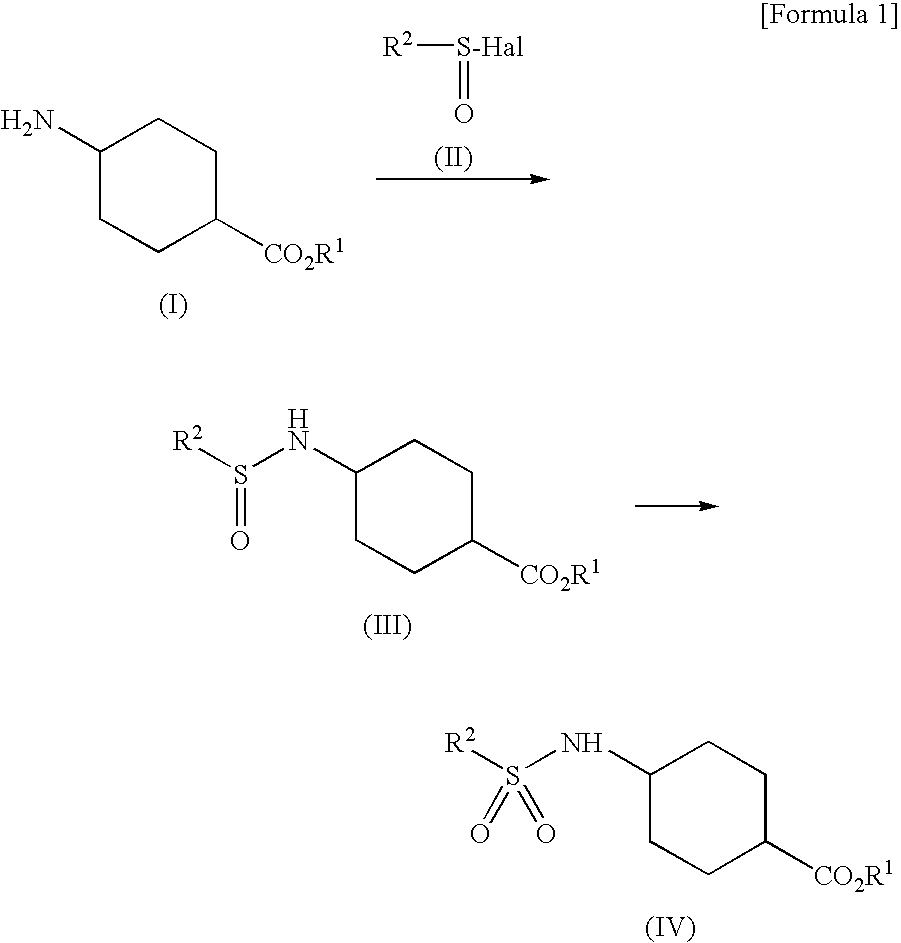Process For the Preparation of Sulfomate-Carboxylate Derivatives
- Summary
- Abstract
- Description
- Claims
- Application Information
AI Technical Summary
Benefits of technology
Problems solved by technology
Method used
Image
Examples
example 1
[0092]
Additive: Water
[0093]To hydrochloride of Compound (I-1) (10.00 g), were added toluene (40 mL), triethylamine (10.72 g) and tap water (20 mL) and the mixture was cooled to 3° C. Compound (II-1) (7.45 g) was added dropwise thereto at 3 to 6° C. over 65 minutes. This reaction solution was stirred at 0 to 10° C. for about 60 minutes and then separated to obtain the upper layer (46.69 g) (Compound (IIIa-1) in toluene solution). To this reaction solution, were added tap water (40 mL) and 48% NaOH solution (10.03 g). The mixture was stirred at about 40° C. for 2 hours, and then separated to obtain the lower layer. 20% sulsuluric acid solution (17.54 g) was added dropwise thereto at 40 to 48° C. to be pH6.5 (Compound (IIIb-1) in the reaction solution). To this reaction solution, was added sodium tungstate dihydrate (794 mg). 35% hydrogen peroxide solution (9.36 g) was added dropwise thereto at 32 to 52° C. over 61 minutes. This reaction solution was stirred at about 40° C. for 90 minu...
example 2
Additive
Isopropanol
[0098]To hydrochloride of Compound (I-1) (7.00 g), were added toluene (28 mL), triethylamine (7.50 g) and isopropanol (7 mL) and the mixture was cooled to 3° C. Compound (II-1) (5.21 g) was added dropwise thereto at 2 to 8° C. over 17 minutes. This reaction solution was stirred at 0 to 10° C. for about 60 minutes. Tap water (14 mL) was added thereto and separated to obtain the upper layer (36.31 g) (Compound (IIIa-1) in toluene solution). To this reaction solution, were added tap water (28 mL) and 48% NaOH solution (7.02 g). The mixture was stirred at about 25° C. for 4 hours, and then separated to obtain the lower layer. 20% sulsuluric acid solution (12.73 g) was added dropwise thereto at about room temperature to be pH7.5 (Compound (IIIb-1) in the reaction solution). To this reaction solution, was added sodium tungstate dihydrate (556 mg). 35% hydrogen peroxide solution (6.55 g) was added dropwise thereto at 40 to 43° C. over 59 minutes. After stirring this reac...
example 3
Additive
[0099]To hydrochloride of Compound (I-1) (7.00 g), were added toluene (35 mL), triethylamine (7.50 g) and methanol (7 mL) and the mixture was cooled to 3° C. Compound (II-1) (5.21 g) was added dropwise thereto at 2 to 9° C. over 48 minutes. Triethylamine (7.50 g) was added thereto and Compound (II-1) (5.21 g) was added dropwise at 2 to 9° C. Triethylamine (7.50 g) was added thereto and Compound (II-1) (5.21 g) was added dropwise at 2 to 9° C. After stirring this reaction solution at 0 to 10° C. for about 30 minutes, tap water (14 mL) was added thereto and separated to obtain the upper layer (46.57 g) (Compound (IIIa-1) in toluene solution). The preparation rate of Compound (IIIa-1) was 94.5%.
[0100]The preparation rates of Compound (IIIa-1) in the above Examples and a case that the additive was not added were compared.
TABLE 1TheThe kindpreparationand amountrate (%) ofThe amount ofof theCompoundAdditivethe additivesolvent(IIIa-1)Example 1Water2VToluene 4V94.6Example 2I...
PUM
| Property | Measurement | Unit |
|---|---|---|
| Volume | aaaaa | aaaaa |
| Fraction | aaaaa | aaaaa |
Abstract
Description
Claims
Application Information
 Login to View More
Login to View More - R&D
- Intellectual Property
- Life Sciences
- Materials
- Tech Scout
- Unparalleled Data Quality
- Higher Quality Content
- 60% Fewer Hallucinations
Browse by: Latest US Patents, China's latest patents, Technical Efficacy Thesaurus, Application Domain, Technology Topic, Popular Technical Reports.
© 2025 PatSnap. All rights reserved.Legal|Privacy policy|Modern Slavery Act Transparency Statement|Sitemap|About US| Contact US: help@patsnap.com



